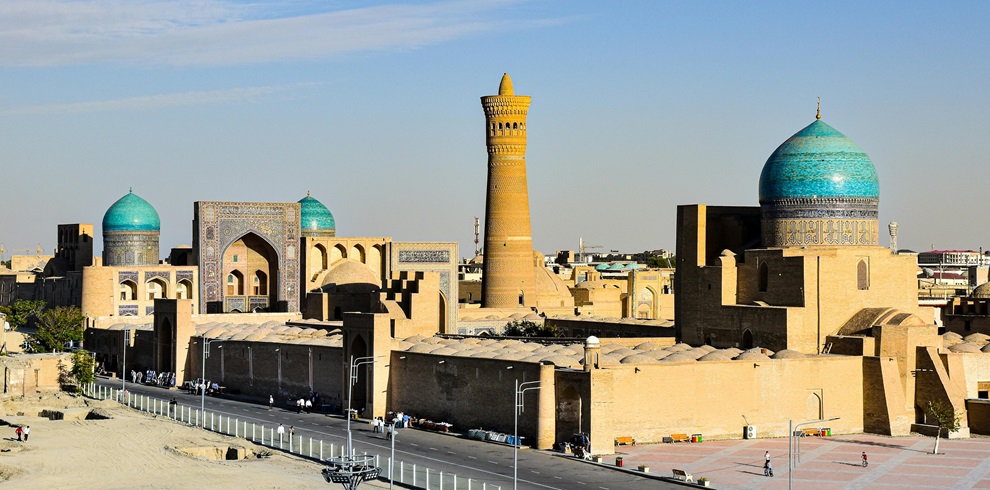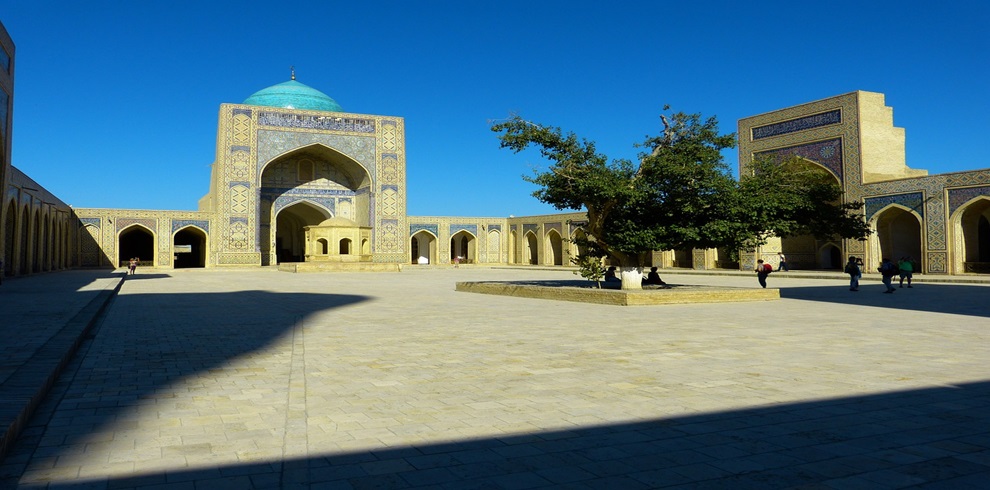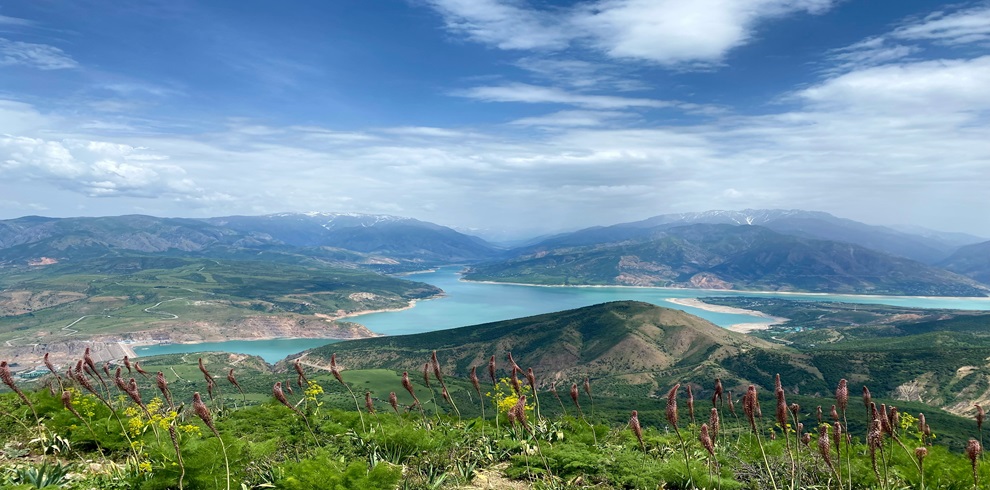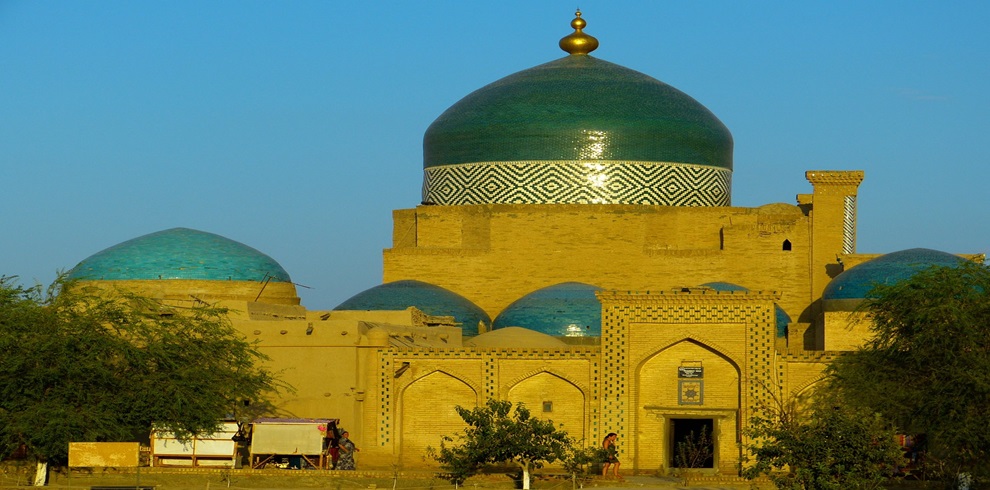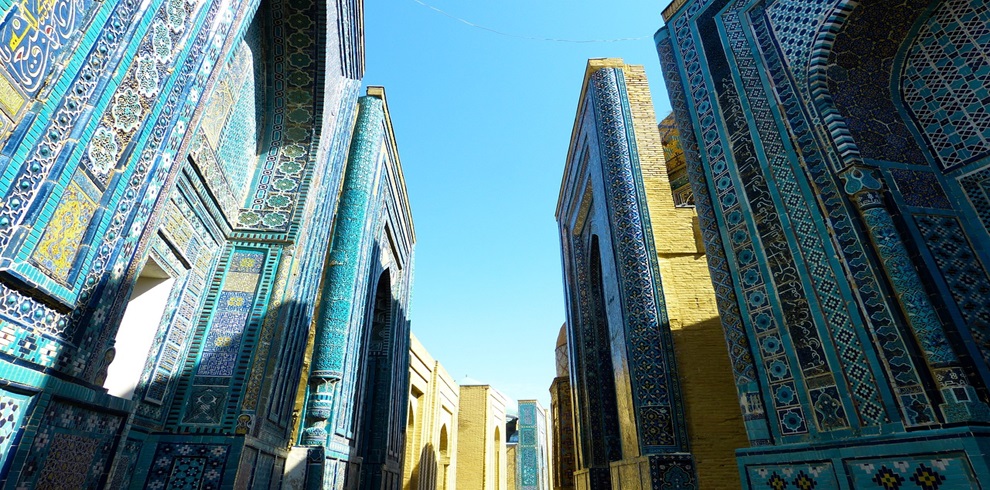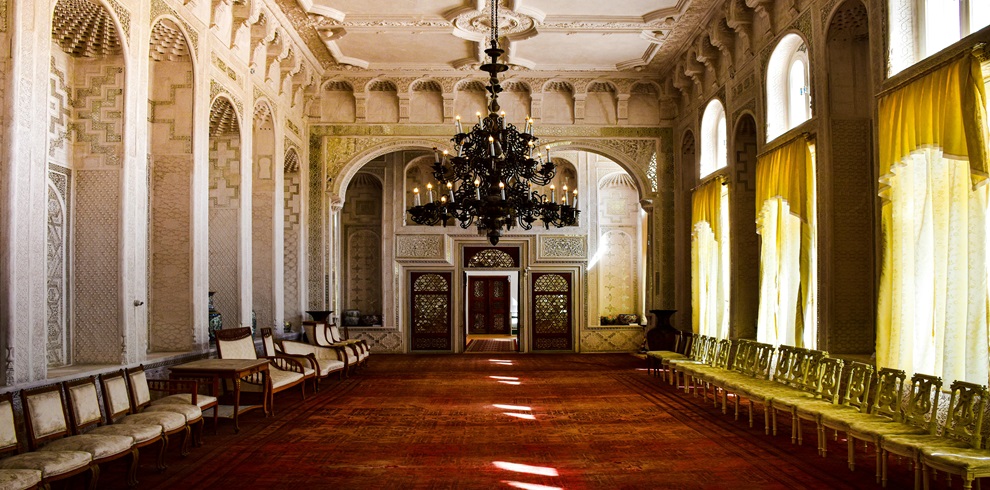Khiva
Khiva is a museum city that amazes with its calm and tranquility. No wonder it is considered the pearl of Uzbekistan, located in the desert. Once upon a time, caravans of the Great Silk Road passed here. Khiva was also the capital of the Khiva Khanate.
Once in Khiva, you will find yourself in a real medieval city, where the spirit of modernity is revealed only by electric wires. Cobblestone streets, clay mosques, elaborate patterns and majestic fortress walls will impress even the most advanced tourist. The entire old town is a UNESCO World Heritage Site.
- The Lyabi-Khauz complex (XVI-XVII centuries) is a historical source of water supply in Bukhara. Around this ancient pool (36×42 m), 5 m deep, three monumental monuments of the 16th-17th centuries were built. These are the Kukeldash madrasah (1568-1569), the khanaqah (1619-1620) and the Nadir Divan-Begi madrasah. They all form a single ensemble.
- Magoki-Attori Mosque (XII century) – an Islamic mosque dating back to Zoroastrianism. Its portals are a masterpiece of architectural decoration: they are decorated in a variety of ways – alabaster carvings, polished brickwork, glazed majolica and carved terracotta.
- Chor-Minor Madrasah (1807) – translated as “four minarets”. This name is quite justified: in the corners of the square-rectangular building of the madrasah there are actually four small minarets crowned with blue domes, the decor of which does not repeat each other. There is an opinion that the artistic design elements of these towers reflect the religious and philosophical understanding of the four world religions.
- Trade domes – Trade dome Toki-Sarrofon (Once there was the largest currency exchange in Central Asia), Trade dome Telpak Furushon (in which hats were sold, later the trade in hats gave way to souvenir products of local artisans), Trade dome Tim Abdullahan (here traded carpets and fabrics), Toki-Zargaron trading dome (Once there were 36 jewelry workshops and stores selling a wide variety of jewelry)
- Kalyan Minaret (1127) – a symbol of the city of Bukhara. From any point in the city this vertical is visible, which is inseparable from the complex silhouette of the city with its row of portals, towers and domes. The main purpose of the minaret is to call Bukharians to prayer.
- Kalyan Mosque (XV century) – considered one of the oldest and second largest after the Samarkand Bibi-Khanum Mosque in all of Central Asia. About 10 thousand people could pray here at one time. Now this is the cathedral mosque of the city; people pray here on Fridays and on holidays.
- Miri-Arab Madrasah (XVI century) – is a functioning madrasah, where future imams and religious mentors are trained. And storks nest on the domes of the madrasah, flying here from Egypt year after year.
- Ulugbek Madrasah (1417) is a rectangular building with a courtyard and a main entrance decorated with a high portal. There are towers – guldasta. Astral elements predominate in the motifs of the ornament, which can be associated with the worldview of Ulugbek as an astronomer.
- Madrasah of Abdulazizkhan (1651-1652) – There are images of the Chinese dragon and the Semurg bird. The madrasah has two mosques – winter and summer. The portal of the madrasah amazes with its height and rich exterior decoration.
- Ark Fortress (IV century BC) – an ancient symbol of state power. It seems that since the very creation of the world this huge fortress has stood in the center of Bukhara, which has always been a protection and support for the Bukhara rulers. For centuries, Ark remained the main residence of the Bukhara emir, the place from which the country’s supreme command was exercised.
- Bolo-Khauz Mosque (1712) – the only surviving monument on Registan Square. The complex consists of a reservoir, a Friday mosque and a minaret.
- Samanid Mausoleum (IX century) – the family tomb of the rulers of the Samanid dynasty is one of the best examples of architecture from the period of the reign of the Samanid dynasty (875-999).
- Chashma-Ayub Mausoleum (XII-XVI centuries) – translated as “The Source of Saint Job”. Legend has it that the biblical prophet Job visited this land and decided to help people suffering in the desert from lack of water. He hit the ground with his stick, and a source of crystal clear water appeared in that place.
- Sitorai Mokhi-Khosa (XIX century) – the summer residence of the last Bukhara emir. Here you can see Venetian mirrors, Japanese mirrors enclosed in unusual frames, and even a trellis that creates a reflection that is repeated 40 times.
- Mausoleum of Bahouddin Naqshbandi (1544) – the founder of the Naqshbandi Sufi order. Every self-respecting Muslim knows and honors this name. It is known that Naqshbandi was Temur’s spiritual mentor and performed the Hajj to Mecca 32 times. The mausoleum of Saint Bahouddin Naqshband is considered the Central Asian Mecca.
- Necropolis Chor-Bakr (XVI century) is a truly unusual, mysterious place. When visiting Chor-Bakr, it is impossible not to feel the breath of the world of the dead, where in the silence of the alleys one involuntarily thinks about the frailty of existence and the transience of human life.
Cultural Tours
Uzbekistan cultural tours introduce you to the different regions and traditions of Uzbekistan, and take you deeper into the history and beauty of this great country. Go beyond the program of a regular group tour and explore the architectural monuments of Uzbekistan’s greatest cities, plus the workshops of master craftsmen and the kitchens of talented chefs.
Each region in Uzbekistan boasts of a unique culture and architectural style, plus different spices in their cuisines and patterns on their textiles and pottery. For example, Khiva is most famous for its ancient technologies for creating hand-dyed natural carpets from silk and wool, while Bukhara has been home to master metalworkers for centuries. In Samarkand, visit the monumental architecture of Timur’s capital, or explore the patterns used for suzani, traditional hand embroideries. Head to the Fergana Valley to learn how ikat patterns are woven in silk, or visit Kashkadarya to learn about the basma and iroqi weaving styles that adorned the clothes of ancient rulers. For those who love ceramics, a visit to Rishtan, the home of famous blue ceramics, is a must.
Take your time in museums, historical sights, folklore fairs, and festivals. Bring back not only colorful souvenirs and bright photos, but also new impressions and memories of the unique culture and history of this land.
- Jan
- Feb
- Mar
- Apr
- May
- Jun
- Jul
- Aug
- Sep
- Oct
- Nov
- Dec
- Jan
- Feb
- Mar
- Apr
- May
- Jun
- Jul
- Aug
- Sep
- Oct
- Nov
- Dec
- Jan
- Feb
- Mar
- Apr
- May
- Jun
- Jul
- Aug
- Sep
- Oct
- Nov
- Dec
- Jan
- Feb
- Mar
- Apr
- May
- Jun
- Jul
- Aug
- Sep
- Oct
- Nov
- Dec
- Jan
- Feb
- Mar
- Apr
- May
- Jun
- Jul
- Aug
- Sep
- Oct
- Nov
- Dec
- Jan
- Feb
- Mar
- Apr
- May
- Jun
- Jul
- Aug
- Sep
- Oct
- Nov
- Dec
- Jan
- Feb
- Mar
- Apr
- May
- Jun
- Jul
- Aug
- Sep
- Oct
- Nov
- Dec
Gastronomic tours
A gastronomic tour to Uzbekistan with excursions takes place in the main tourist cities – Samarkand, where the Macedonian heritage has been preserved, Bukhara, where they will tell about the cheerful adventures of the cunning Khoja Nasreddin, the “cradle” of the pottery art of our country – Gijduvan and the small town of Vabkent with the minaret of the same name, which challenged “elder Bukhara brother” Kalyan. Each city represents a specific milestone in the history of Uzbekistan – a history as old as the world.
A culinary tour to Bukhara and Samarkand is a way of re-reading the heritage of Asia, honored to be included in the UNESCO World Heritage List. In addition to the Registan of Bukhara – yes, don’t be surprised, in ancient times there was a “registan” – that is, the main city square was present in every eastern city, visits to family in Gijduvan, where the ancient secrets of making ceramics are passed down from generation to generation, and visits to the Tamerlane mosque – Bibi Khanym , on a gastronomic tour of Uzbekistan in 5 days you will experience the true “Taste of the East”.
Combine the “Classical Uzbekistan” excursion tour with knowledge of the cultural layer inherent in the culinary traditions of the Uzbek people. The guides specialize in receiving guests from Russia and will tell the history of Uzbekistan with parallels to the events that took place in Rus’ at that time.
Excursions in Bukhara, due to the walking distance of the main attractions, are on foot, in the fresh air, so by the time of lunch, after a satisfied hunger for impressions and new knowledge, you will have a lion’s appetite.
We promise that traditional dishes with interesting gastro excursions will produce no less effect than the delight caused by the architectural masterpieces of Samarkand and Bukhara:
1. Bukhara kazan-kabob is a classic piece in the music of Uzbek cooking, prepared from steamed lamb, rich in spices.
2. Tasting lagman in Bukhara will appeal to those who love meat and seasonal vegetables cooked over a fire.
3. In Samarkand you will try Uzbek shish kebab and pilaf. Why here? There are 100 types of pilaf in Asia. Samarkand residents have found 99 types of cooking kebabs – here you will find your favorite variety and discover new shades of taste. By the way, about pilaf – 100 varieties and the gastronomic tour program includes Samarkand pilaf, laid out in layers.
4. Manti is a favorite holiday dish of Uzbek families, like pilaf and somsa, which are already popular far beyond Asia. See how culinary master Mubaro Sharipovna in the guest house makes a gossamer-thin dough that can hold a handful of meat filling, and of course, repeat this trick, which will further delight your guests.
5. Dimlyama in Uzbekistan is an unusual steamed stew of meat and vegetables, including tomatoes and eggplants, which is as satisfying as it is appetizing.
A gastronomic tour to Uzbekistan from Moscow involves not only tasting and contemplation, but direct participation in culinary master classes, where local residents will tell you secrets and tricks that cannot be found on the Internet.
Uzbek cuisine owes its complexity and richness to nomadic traditions and, of course, to the Great Silk Road – a fusion of the early Middle Ages, transforming and enriching itself over the centuries. The preparation of Uzbek dishes is characterized by ritualism – we will tell you why on Thursdays in Uzbekistan everyone eats pilaf, and only men should cook it.
- Jan
- Feb
- Mar
- Apr
- May
- Jun
- Jul
- Aug
- Sep
- Oct
- Nov
- Dec
- Jan
- Feb
- Mar
- Apr
- May
- Jun
- Jul
- Aug
- Sep
- Oct
- Nov
- Dec
- Jan
- Feb
- Mar
- Apr
- May
- Jun
- Jul
- Aug
- Sep
- Oct
- Nov
- Dec
- Jan
- Feb
- Mar
- Apr
- May
- Jun
- Jul
- Aug
- Sep
- Oct
- Nov
- Dec
- Jan
- Feb
- Mar
- Apr
- May
- Jun
- Jul
- Aug
- Sep
- Oct
- Nov
- Dec
- Jan
- Feb
- Mar
- Apr
- May
- Jun
- Jul
- Aug
- Sep
- Oct
- Nov
- Dec
- Jan
- Feb
- Mar
- Apr
- May
- Jun
- Jul
- Aug
- Sep
- Oct
- Nov
- Dec
Hiking
Embark on an extraordinary journey that delves deep into Uzbekistan’s treasures, offering thrilling trekking, hiking, and cultural tours. Step off the beaten path and immerse yourself in the heart of local life. With us, you’re not just a traveller; you become a part of the rich tapestry woven by local communities. You’llexplore remote villages, connect with locals, live alongside families, and partake in everyday moments that provide profound insights into the culture.
For adventurers seeking to traverse timeless landscapes, our multi-day hiking and trekking expeditions departing from Tashkent, Samarkand, Bukhara, and beyond are a gateway to a thrilling adventure. Roam through rugged terrains and follow trails that unveil the hidden gems of Uzbekistan’s natural beauty. This is more than a physical journey; it’s an opportunity to uncover the land’s history, diverse cultures, and its warm-hearted people. Rest assured that each step is guided by experienced professionals, accompanied by comfortable accommodations, and meticulously crafted itineraries to make your exploration smooth and seamless.
These are not your typical tours; they are experiences that offer you a unique chance to view Uzbekistan through the eyes of those who proudly call it home.||
- Jan
- Feb
- Mar
- Apr
- May
- Jun
- Jul
- Aug
- Sep
- Oct
- Nov
- Dec
- Jan
- Feb
- Mar
- Apr
- May
- Jun
- Jul
- Aug
- Sep
- Oct
- Nov
- Dec
- Jan
- Feb
- Mar
- Apr
- May
- Jun
- Jul
- Aug
- Sep
- Oct
- Nov
- Dec






